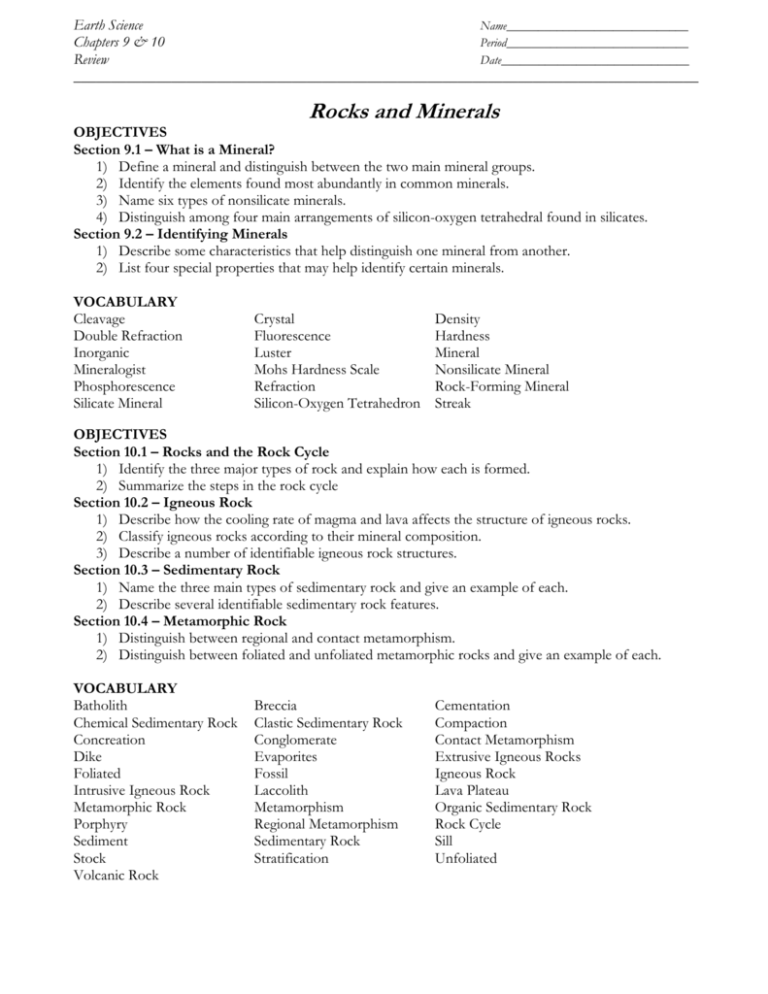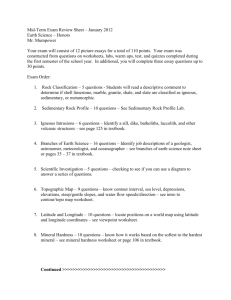Igneous Rock
advertisement

Earth Science Name_____________________________ Chapters 9 & 10 Period_____________________________ Review Date______________________________ ___________________________________________________________________________________ Rocks and Minerals OBJECTIVES Section 9.1 – What is a Mineral? 1) Define a mineral and distinguish between the two main mineral groups. 2) Identify the elements found most abundantly in common minerals. 3) Name six types of nonsilicate minerals. 4) Distinguish among four main arrangements of silicon-oxygen tetrahedral found in silicates. Section 9.2 – Identifying Minerals 1) Describe some characteristics that help distinguish one mineral from another. 2) List four special properties that may help identify certain minerals. VOCABULARY Cleavage Double Refraction Inorganic Mineralogist Phosphorescence Silicate Mineral Crystal Fluorescence Luster Mohs Hardness Scale Refraction Silicon-Oxygen Tetrahedron Density Hardness Mineral Nonsilicate Mineral Rock-Forming Mineral Streak OBJECTIVES Section 10.1 – Rocks and the Rock Cycle 1) Identify the three major types of rock and explain how each is formed. 2) Summarize the steps in the rock cycle Section 10.2 – Igneous Rock 1) Describe how the cooling rate of magma and lava affects the structure of igneous rocks. 2) Classify igneous rocks according to their mineral composition. 3) Describe a number of identifiable igneous rock structures. Section 10.3 – Sedimentary Rock 1) Name the three main types of sedimentary rock and give an example of each. 2) Describe several identifiable sedimentary rock features. Section 10.4 – Metamorphic Rock 1) Distinguish between regional and contact metamorphism. 2) Distinguish between foliated and unfoliated metamorphic rocks and give an example of each. VOCABULARY Batholith Chemical Sedimentary Rock Concreation Dike Foliated Intrusive Igneous Rock Metamorphic Rock Porphyry Sediment Stock Volcanic Rock Breccia Clastic Sedimentary Rock Conglomerate Evaporites Fossil Laccolith Metamorphism Regional Metamorphism Sedimentary Rock Stratification Cementation Compaction Contact Metamorphism Extrusive Igneous Rocks Igneous Rock Lava Plateau Organic Sedimentary Rock Rock Cycle Sill Unfoliated REVIEW QUESTIONS Mineral Uses 1. List some common mineral uses. 2. How are minerals used in the home? Give several examples. 3. What minerals do you use just to have breakfast? 4. What has asbestos removal cost schools? 5. Compare and contrast white and blue asbestos. 6. Compare your chances at dying from asbestos to another leading cause of death. The Definition of a Mineral 7. List and describe the characteristics a substance needs to have to be a mineral according to geologists. Mineral Groups 8. What is the largest of the two major groups of minerals? What elements do these minerals have in them? How abundant are these minerals in the Earth’s crust? 9. What is the second of the two major groups of minerals? List and describe each of the subgroups in this main mineral group. How abundant are these minerals in the Earth’s crust? 10. How many different types of known minerals are there? How many rock-forming minerals are there? Name the 10 minerals that make up 90% of the Earth’s crust. Physical Properties of Minerals 11. What is crystal form? Give an example. 12. Is color a good diagnostic property of minerals? Why? Give an example in your explanation. 13.What is luster? List the different types of luster and give a short description of each. What kind of luster does quartz have? 14. How is the hardness of minerals compared? What are the three possible answers you could give me if I were to ask you the hardness of a mineral? What is the hardness of talc, your fingernail, glass, and diamond on the Mohs hardness scale? 15. What does cleavage describe about a mineral? List each of the possible cleavage directions and describe the things to look for. Give an example of a mineral that displays each of the possible cleavage directions. 16. How is streak useful in identifying minerals? Give an example. 17. What is specific gravity? 18. List and describe three special properties of minerals and tell what mineral each of them successfully identifies. The Rock Cycle 19. List the five Earth materials found in the rock cycle. 20. List the five Earth processes found in the rock cycle. 21. Draw the rock cycle. How are rocks formed anyway? Igneous Rocks 22. Igneous rocks are rocks from __________. How are igneous rocks formed? 23. How do intrusive igneous rocks form? 24. Compare and contrast the different ways in which magma is contained. 25. Why do intrusive igneous rocks have large crystals? Give an example in your discussion. 26. How are extrusive igneous rocks formed? Why do they form small or no crystals? Give an example in your discussion. Sedimentary Rocks 27. How do most sedimentary rocks form? 28. What is sediment and how is it made? 29. Describe the process of compaction and cementation. How exactly does a rock get cemented together? 30. How does a clastic sedimentary rock form? List some examples of clastic sedimentary rocks. 31. Describe two ways that a chemical sedimentary rock can form. List some examples of chemical sedimentary rocks. 32. How does an organic sedimentary rock form? List some examples of organic sedimentary rocks. Metamorphic Rocks 33. What is metamorphosis and how does it happen in rocks? 34. What is contact metamorphism? Draw a picture to aid in your description. 35. What is regional metamorphism? Draw a picture to aid in your description. 36. Can contact metamorphism take place in an area undergoing regional metamorphism? Explain. Classifying Rocks Texture 37. What does the texture of a rock refer to? 38. Describe how big the different grain sizes are in practical terms. Give examples for each. 39. In which type of rock does the shape of the grains matter? 40. Which types of rocks display an interlocking texture? Which type of rocks display a cemented or compacted texture? Igneous 41. Describe glassy and frothy textures and give examples of each. 42. What is a porphyritic texture? Metamorphic Rocks 43. Compare and contrast foliated with non-foliated metamorphic rocks. Composition of Igneous Rocks 44. Describe the color, elemental content, and % silica of felsic igneous rocks. 45. Describe the color, elemental content, and % silica of mafic igneous rocks. 46. Describe the color, elemental content, and % silica of intermediate igneous rocks. Composition of Sedimentary Rocks 47. List and describe the different types of cement that hold together sedimentary rocks. Composition of Metamorphic Rocks 48. List two metamorphic rocks that are made up of just one mineral. List the mineral makeup for each. 49. List two metamorphic rocks that are made up of more than one mineral. List the mineral makeup for each.








